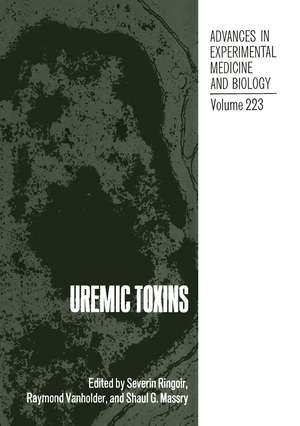Uremic Toxins: Advances in Experimental Medicine and Biology, cartea 223
Editat de Severin Ringoir, Raymond Vanholder, Shaul G. Massryen Limba Engleză Paperback – 3 apr 2012
Din seria Advances in Experimental Medicine and Biology
- 9%
 Preț: 719.56 lei
Preț: 719.56 lei - 5%
 Preț: 1113.83 lei
Preț: 1113.83 lei - 20%
 Preț: 691.93 lei
Preț: 691.93 lei - 5%
 Preț: 717.00 lei
Preț: 717.00 lei - 5%
 Preț: 717.00 lei
Preț: 717.00 lei - 5%
 Preț: 715.35 lei
Preț: 715.35 lei - 5%
 Preț: 716.28 lei
Preț: 716.28 lei - 5%
 Preț: 239.86 lei
Preț: 239.86 lei -
 Preț: 642.95 lei
Preț: 642.95 lei - 5%
 Preț: 820.42 lei
Preț: 820.42 lei - 5%
 Preț: 715.71 lei
Preț: 715.71 lei - 15%
 Preț: 640.24 lei
Preț: 640.24 lei - 15%
 Preț: 641.38 lei
Preț: 641.38 lei - 5%
 Preț: 1031.00 lei
Preț: 1031.00 lei - 5%
 Preț: 716.28 lei
Preț: 716.28 lei - 5%
 Preț: 717.20 lei
Preț: 717.20 lei - 20%
 Preț: 1161.71 lei
Preț: 1161.71 lei - 5%
 Preț: 1170.51 lei
Preț: 1170.51 lei - 18%
 Preț: 1119.87 lei
Preț: 1119.87 lei - 5%
 Preț: 1288.48 lei
Preț: 1288.48 lei - 5%
 Preț: 1164.67 lei
Preț: 1164.67 lei - 5%
 Preț: 1101.73 lei
Preț: 1101.73 lei - 18%
 Preț: 1123.67 lei
Preț: 1123.67 lei - 5%
 Preț: 1435.64 lei
Preț: 1435.64 lei - 20%
 Preț: 1044.10 lei
Preț: 1044.10 lei - 18%
 Preț: 946.39 lei
Preț: 946.39 lei - 5%
 Preț: 292.57 lei
Preț: 292.57 lei - 18%
 Preț: 957.62 lei
Preț: 957.62 lei - 18%
 Preț: 1235.76 lei
Preț: 1235.76 lei - 5%
 Preț: 1231.55 lei
Preț: 1231.55 lei - 5%
 Preț: 1292.30 lei
Preț: 1292.30 lei - 5%
 Preț: 1102.10 lei
Preț: 1102.10 lei - 18%
 Preț: 1132.81 lei
Preț: 1132.81 lei - 5%
 Preț: 1165.19 lei
Preț: 1165.19 lei - 5%
 Preț: 1418.48 lei
Preț: 1418.48 lei - 5%
 Preț: 1305.63 lei
Preț: 1305.63 lei - 18%
 Preț: 1417.72 lei
Preț: 1417.72 lei - 18%
 Preț: 1412.99 lei
Preț: 1412.99 lei - 24%
 Preț: 806.15 lei
Preț: 806.15 lei - 18%
 Preț: 1243.29 lei
Preț: 1243.29 lei - 5%
 Preț: 1429.44 lei
Preț: 1429.44 lei - 5%
 Preț: 1618.70 lei
Preț: 1618.70 lei - 5%
 Preț: 1305.12 lei
Preț: 1305.12 lei - 18%
 Preț: 1124.92 lei
Preț: 1124.92 lei - 5%
 Preț: 1097.54 lei
Preț: 1097.54 lei - 15%
 Preț: 649.87 lei
Preț: 649.87 lei - 5%
 Preț: 1097.54 lei
Preț: 1097.54 lei - 18%
 Preț: 945.79 lei
Preț: 945.79 lei
Preț: 393.52 lei
Nou
Puncte Express: 590
Preț estimativ în valută:
75.34€ • 78.61$ • 63.15£
75.34€ • 78.61$ • 63.15£
Carte tipărită la comandă
Livrare economică 12-26 martie
Preluare comenzi: 021 569.72.76
Specificații
ISBN-13: 9781468454475
ISBN-10: 1468454471
Pagini: 312
Ilustrații: 296 p.
Dimensiuni: 178 x 254 x 16 mm
Greutate: 0.54 kg
Ediția:Softcover reprint of the original 1st ed. 1987
Editura: Springer Us
Colecția Springer
Seria Advances in Experimental Medicine and Biology
Locul publicării:New York, NY, United States
ISBN-10: 1468454471
Pagini: 312
Ilustrații: 296 p.
Dimensiuni: 178 x 254 x 16 mm
Greutate: 0.54 kg
Ediția:Softcover reprint of the original 1st ed. 1987
Editura: Springer Us
Colecția Springer
Seria Advances in Experimental Medicine and Biology
Locul publicării:New York, NY, United States
Public țintă
ResearchCuprins
Parathyroid Hormone: A Uremic Toxin.- Retention Patterns.- Middle Molecules and the 7 C Factor.- Middle Molecules as a Marker of Uremic Toxins.- The Abiko Factor.- Polyamines and Uremia.- Roles of Hippurate and Indoxyl Sulfate in the Impaired Ligand Binding by Azotemic Plasma.- Hippuric Acid as a Marker.- Suppressive Effect of Quinolinic Acid and Hippuric Acid on Bone Marrow Erythroid Growth and Lymphocyte Blast Formation in Uremia.- Purine Metabolites in Uraemia.- The Role of Lipids in Progressive Glomerular Disease.- Aluminum an Uremic Toxin.- The Insulin-Resistance Inducing Factor Associated with Uremia.- Pathogenesis and Consequences of the Alteration of Glucose Metabolism in Renal Insufficiency.- Separation of Peptidic Inhibitor of Erythropoiesis in Uremia.- Uremic Toxins Inhibit the Platelet Malonyldialdehyde Production Rate.- A Possible Regulatory System of Microtubule Formation Among Uremic Toxins.- Encephalopathic Toxicity: An Experimental Model of Uremia and Solute—Specific Dialysis.- Intellectual Impairment in Chronic Renal Failure.- The Fraction b 4-2: Isolation, Characterization and Biological Activities with Reference to Uremic Polyneuropathy.- Intracellular Acid-Base and Energy Metabolism in Uremia: A Preliminary Study of Five Patients Before and During Dialysis Treatment.- Is Selenium Deficiency the Cause of Uraemic Cardiomyopathy?.- Does Hypermagnesemia Suppress Parathyroid Activity and Therefore Play a Role in Amelioration of Uremic Toxicity?.- Synthesis and Structure-Activity Relationships of Thymopoietin.- The Immunosuppressive Fraction Isolated from Uremic Ultrafiltrates: Attempted Characterization of the Mechanism of Action.- Isolation of an Immunosuppressive Fraction from Uremic Ultrafiltrates.- Binding of Organic Acids to Surface Receptors ofLymphocytes as an Immunosuppressive Mechanism in Uremia.- Uremic Dysmetabolism and its Effect on Immunocompetent and Erythroid Cell Function.- Conversion of Ammonia to Glutamate by L-Glutamic Dehydrogenase, Alcohol Dehydrogenase and NAD+ Immunobilized within Lipid-Polyamide Polyethyleneimine Microcapsules.- A Purification Method by Uncoated Charcoal.- Amino Acid Composition of Uremic Middle and Low Molecular Weight Retention Products.- Biochemical Elucidation and HPLC Fractionation of Fluorescent Peptides in Patients with Chronic Renal Failure.- Separation from Uremic Body Fluids and Normal Urine of Na+, K+-ATPase Inhibitor.- Isolation of Sialylcompounds from Hemofiltrate of Chronic Uremic Patients and Identification by Nuclear Magnetic Resonance.- Identification of Two Uremic toxins by Nuclear Magnetic Resonance and Mass Spectrometry.- Kinetic of Solute Removal in Hemodialysis.- An Advanced, User-Friendly Microcomputer Program for Hemodialysis Kinetics.- Is Serum Urea a Good Index for Predicting Morbidity in Hemodialysis (HD)?.- Predicted time of Dialysis in Patients with Different Volumes of Urea Distribution—The Use of Mathematical Model.- Membranes and their Removal of Uremic Toxins.- Replacement of Excretory Kidney Function by High-Efficiency Hemodiafiltration (HDF) with a Peptide-Permeable Membrane.- Paired filtration-Dialysis (PFD): A Separate Convective-Diffusive System for Extracorporeal Blood Purification in Uraemic Patients.- Removal of Small Proteins—The Stepchild of Dialysis Therapy Protein Permeability of Different Hemofiltration Membranes Analysed by SDS-Poly-acrylamide Gel Electrophoresis (SDS-Page).- Hemofiltration-Induced Serum Modifications in the Pattern of Larger Molecules.- Carnitine Depletion During Chronic Hemodialysisi Effect ofSubstitution on Free Carnitine Plasma Levels.














